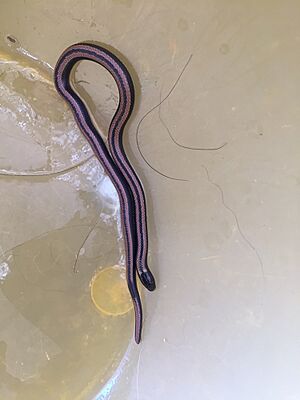Phalotris lemniscatus facts for kids
Quick facts for kids Phalotris lemniscatus |
|
|---|---|
 |
|
| Conservation status | |
| Scientific classification | |
| Genus: |
Phalotris
|
| Species: |
lemniscatus
|
Meet the Phalotris lemniscatus, a cool snake found in South America. It's also known as the Pampeana black-headed snake or Duméril's diadem snake. This snake is venomous, but it's usually very shy and not aggressive towards people.
Contents
About the Pampeana Black-Headed Snake
This snake is quite slender, meaning it has a thin body. Its head is relatively small, and it has a short tail. Most of these snakes are about 50 centimeters (about 20 inches) long. However, some have been found to be a bit longer, up to 68 centimeters (about 27 inches).
What it Looks Like
The Phalotris lemniscatus has a unique color pattern. Its back is usually reddish or orange. It has black lines running along its body. The line in the middle of its back might be missing or very faint. Its head is mostly black, and it has a white band around its neck. This special design helps identify it easily.
Where it Lives and What it Eats
This snake likes to live underground or hide in burrows. This helps it stay hidden, especially in areas where people live. It eats small reptiles like amphisbaenians (worm lizards), other small snakes, and lizards.
How it Behaves
When a human is nearby, this snake usually acts shy. It will try to get away and is never aggressive. It prefers to avoid contact and hide.
Where the Snake is Found
The Phalotris lemniscatus lives in many parts of South America. You can find it in Rio Grande do Sul in Brazil, and in northern Argentina. Its range also extends to the border areas of Bolivia and Paraguay. In Uruguay, it lives all across the country. This snake often lives in open areas. It can also adapt well to cities and towns.
Understanding its Venom
The venom of the Phalotris lemniscatus contains special proteins. These proteins can affect blood and other body functions. Scientists study these proteins to understand how the venom works.
What Happens if You Get Bitten
Bites from this snake are rare because it is shy. However, there have been a few recorded cases. In one case, a 13-year-old boy was bitten on his finger. After some hours, he started to have minor bleeding from his gums. Tests showed that his blood was not clotting normally. He was given medicine to help his blood clot.
In another case, an older woman was bitten. She felt some pain and had a mild headache. She also experienced some bleeding. She needed special care and medicine to help her recover.
It's important to remember that these snakes are not aggressive. They usually only bite if they feel threatened or are handled. If someone is bitten, it's always best to get medical help right away.


